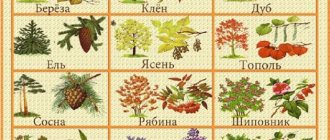Conversation for younger schoolchildren on the topic “Wild berries”
About wild berries for schoolchildren.
Summary of an extracurricular lesson with presentation Author: Danilchenko Oksana Anatolyevna, head of the department for the main activities of the State Educational Institution “Slutsk Ecological and Biological Center for Students” Description: The scenario development is intended for primary school students and is of interest to primary school teachers, teachers of preschool educational institutions, as well as teachers additional education in ecological and biological profile. The material introduces wild berries of the Republic of Belarus and contains poems that contribute to the development of aesthetic taste in children. A presentation is attached to the publication, which is recommended to be demonstrated during the conversation.
Duration of the lesson: 2 academic hours (45 minutes each) Purpose: to help expand students’ knowledge about forest plants. Objectives: Educational – to contribute to the expansion of knowledge about the diversity of berry plants in the Republic of Belarus. Developmental – promote the formation of curiosity and attentiveness. Educational – to promote a culture of communication and respect for nature. Teaching methods used in the training session: - verbal method; - visual method; - gaming. Material and technical support for the training session: paper, pens, colored pencils, illustrations of wild berries, a selection of tasks about wild berries in Belarus, multimedia presentation “Edible wild berries of the Republic of Belarus”. Preparation for the lesson: 1. Conversation about safety measures.
2. Familiarization with the purpose of the lesson. 3. Students prepare poems about wild berries. Conducting a conversation
Introduction
Teacher: Today we will get acquainted with forest berry crops, learn about their places of growth, their role in nature and in human life.
People have been growing berry crops for many years. These are currants, gooseberries, sea buckthorn and many others. But today we will talk about wild berries. The main part of the conversation
Teacher: Guys, imagine that it is now a warm June day, and you and I are in a forest clearing. In the heat of the stumps There are many thin lights. Each thin stalk holds a scarlet stalk. We raked the stems and collected the lights. What kind of berry do you think we are talking about? That's right, it's strawberries. (An illustration of strawberries is shown) One of the students reads a poem about strawberries. Strawberries In a thawed forest Strawberry under a pine tree. The small strawberry blossomed well in the spring. Bees sat on it, the May beetle flew over it. Her neighbor is cheerful - Spring among the stones. The sun warmed for many days. A lush bush near the stones. The strawberry became bigger and bigger in the hallway. She blushed on every side, filled with fragrant juice. E. Trutneva Teacher: Strawberry is a perennial herbaceous plant with a short rhizome and creeping shoots, which, taking root, give rise to new plants. The flowers of the plant are white and the berries are red with a subtle pleasant aroma. The home of strawberries is forest edges and clearings. She needs a lot of light and warmth. Strawberries are used to make compotes, preserves, and jams. It is very useful in its fresh form. The leaf and root are used to treat kidney problems and colds. To pick strawberries you need to put in a lot of work. One of the students reads
a poem about strawberries . Summer is a strawberry, close to the ground, hiding its face in the uncut grass.
Either she will appear, or she will disappear, Blushing until we meet, A desperate prude From the queen berries. But, so as not to repent later, (After all, her rank is high!) If you bow at your feet, you will fill the container. N. Perminova (You can offer to watch the animated film “The Pipe and the Jug”) Assignment: Students are asked to look at the strawberry herbarium and sketch the plant, as well as label the leaf, flower, and root.
Teacher: Next to the strawberries, another berry grows. It is characteristic of coniferous forests and loves wetter places than strawberries. One of the students reads
a poem about blueberries . The sun scatters arrows, lighting up the pine trees.
What kind of berry is ripe, so blue? Someone threw the beads into pieces, under the leaves, All the clearings are dotted with blue, By the green pines. We collected blueberries in a box, in a basket... Only our mouths somehow became a little black. E. Trutneva (An illustration of blueberries is demonstrated) Teacher: Look, blueberries have pale pink, greenish small flowers. They look like balls the size of a pea. Flowering does not last long, blueberries are juicy and tender. This plant got its name from the color of its ripe berries. I was green and small, Then I became scarlet, I turned black in the sun And now I am ripe. Blueberry is a low shrub. Berries and leaves are used for medicinal purposes to improve vision and heal the intestines. Blueberry compotes and jams are delicious. Blueberries ripen in July. Teacher: In the forests you can find a berry very similar to blueberries. Look at the illustration. How are these berries similar and how are they different? (Illustration of blueberries is shown)
Blueberries are larger and have a bluish bloom.
The plant itself loves a lot of moisture. Blueberries are also shrubs. The berries are used mainly fresh. They are useful for improving vision and digestion. Where the forest thicket is shady, Where the earth is hummocky and mossy, Blueberries grow luxuriously - The berries just beg to be in your mouth! Kholodkovsky N. Teacher: If we go for a walk in the forest at the end of summer - beginning of autumn, our attention will definitely be attracted by the bone marrow. Drupes are a rare, tasty and very healthy berry. In tsarist times, the poor collected it and sold it to the rich for a lot of money. Therefore, it was sometimes called the prince's berry. (Demonstration of an illustration of a bone tree) One of the students reads
a poem about a bone tree . Red and tasty, but not strawberries. Drupes grow on the outskirts.
Eat as a seasoning for meat and fish dishes - The berry is very, very useful for people. Use a decoction of the plant to wash hair to strengthen it. A bone leaf will tell you the weather: If it is twisted, there will be a bucket. Kissels, syrups, fruit drinks, jelly, jam Eat stone fruit berries with pleasure. Berries even treat scurvy, and it helps - I’m not lying at all. Those who didn’t eat or take bones didn’t get enough vitamin C. I always collect bones and tell you about their benefits. Koneva N. Assignment: Examine the herbarium of bone marrow. Draw a plant and indicate the leaf, stem, and root in the drawing. Compare with the drawing of strawberries. How are these berry plants similar and how are they different? Teacher: In dry pine, spruce and mixed forests, in sphagnum swamps, another berry grows. The leaves are glossy, the berries are blushed, and the bushes themselves are no higher than a hummock. What kind of berry do you think we are talking about? That's right, it's lingonberries. (An illustration of lingonberries is shown)
Lingonberries are an evergreen shrub, up to 30 centimeters high.
The branches are creeping. The leaves live up to 3 years, lingonberries bloom in late spring. The flowers are small, graceful, snow-white. The fruit is a spherical, dark red with white side, shiny berry. It has a sour-tart taste. Ripens in late August - early September. “Lingonberries grow in a quiet grove, breathing resinous air, leading their whole life as simply as possible, and that’s why they are so good.” ON THE.
Kholodkovsky
A. Kharitonov
about the medicinal properties of lingonberries : It’s a great diuretic if you boil the leaves!
If you suffer from gout, you need to drink this decoction! Fresh lingonberry leaves drive away stones... A berry infusion with water removes thirst in the summer... And it also helps patients with fevers... If you want to strengthen your eyesight, eat live berries... Teacher: I’m red, I’m sour I grew up in the swamp, ripened under the snow Well- ok, who knows me? Of course it's cranberry. (Illustration of cranberry shown)
Cranberry is an evergreen shrub with creeping and rooting stems and small pink flowers.
In September-October the berries turn red and become ripe. One of the students reads
a poem about cranberries . In the forest in the swamp you will find cranberries.
You will bring it home in a wicker basket. Then you will sort it out very carefully, And, adding sugar, you will grind it. When you lick this yummy, you will think with love about the swamp. Simbirskaya Yu. Assignment: Students are asked to assemble puzzles and name the berries.
These are raspberries and blackberries. Teacher: Look at the illustrations (Illustrations of raspberries and blackberries are shown)
How are raspberry and blackberry plants similar and different?
Guys' answers: Raspberries and blackberries are thorny bushes. Raspberries have red berries, and blackberries have black berries. Teacher: There is a legend about raspberries and blackberries. In one village there lived a rich but stingy man. And he had two daughters - very beautiful, but also greedy. Because of this, no one wanted to marry them. Their father went to hell and began to ask that neither his property nor his daughters go to anyone, and that the devil would turn his daughters into thorns that blocked the path to his treasures. The devil happily agreed. And he bewitched his eldest daughter into a blackberry. But at that time a kind magician flew past and turned the youngest daughter into a raspberry. One of the students reads
a poem about cloudberries . Cloudberry On the edge of the swamp, Where the spruce smells, By mid-summer the berries are ripe.
Near each hummock Large cloudberries gathered in flocks on chiseled legs: Pinkish-yellow, Like amber, And each one had a hidden Sun inside. V. Denisov (An illustration of cloudberries is demonstrated) Teacher: Squat cloudberries grow in swamps. In the Republic of Belarus this is a protected plant and is in the Red Book. Interestingly, this is the closest relative of the raspberry. But cloudberry is not a shrub, but a perennial herbaceous plant. It has a thin creeping rhizome, from which low stems with 2-3 leaves grow in the spring. In May - June, rather large flowers with five white, sometimes pinkish petals bloom. Cloudberry fruits are quite interesting. They are called berries. But from a scientific point of view this is wrong. Cloudberries, like their relatives raspberries and blackberries, have a fruit consisting of many small, juicy fruits fused together. Each fruit is like a tiny cherry: there is pulp on the outside and a pit on the inside. And you know what else is surprising? When the fruits are unripe, cloudberries are red. And when they ripen (this happens in August), they become yellow-orange and acquire a pleasant taste. It is very important to preserve this rare plant species in our country. Teacher: Tasty and healthy berries are found not only in forest herbs and shrubs, but also in trees. One of the students reads
a poem about rowan . Where does so much bright blood come from, Rowanushka, in your grapes?
Queen on the autumn throne, it's time for you to give yourself away! Thrushes and red-breasted birds, flying there, where there is shelter. They have long considered your bitter medicine a miracle. Burn, burn, my mountain ash, fly away, little bird! And we have one Motherland, and in some ways even destiny! V. Bokov (An illustration of a rowan is demonstrated) Teacher: Rowan can be found everywhere. It is easily recognized by its small bright red-orange berries collected in clusters, looking like skillfully made beads. This tree looks very elegant and festive. However, people not only admire its beauty, but also use its fruits if they need to be treated for various diseases. One of the students reads
a poem about bird cherry . They break it with huge branches.
Young trees are not spared. And reaches for the country carriages. A bitter aroma similar to crying. The soundless crying did not arise from the fact that if all the grapes were torn off, they would deprive her of her mother’s share, and they would not let her cherish the fragrant berries! ...The bird cherry goes further and further into the wilderness. In the thicket he hides from us. This is how the legend is hidden among the people. This is how swans disappear from the eyes... L. Tatyanicheva (An illustration of a bird cherry is shown) Teacher: There is a sign that when the bird cherry blooms in the spring, it will definitely get colder. Our ancestors learned that bird cherry berries have a beneficial effect on the human body back in the Stone Age. Since that time, from generation to generation, people have been passing on to each other valuable recipes for preparing various decoctions and tinctures from medicinal berries to improve general health and treat many diseases. ASSIGNMENT TASKS
Task 1 Remember and write down all the wild berries that we talked about today. Answer: Raspberries, blackberries, rowan, bird cherry, strawberries, blueberries, blueberries, cranberries, lingonberries, stoneberries, cloudberries. Task 2 Students receive coloring pages of wild berries. Assignment: color and label the berries.
Task 3 Answer questions about wild berries.
1. What wild berry is in the Red Book of the Republic of Belarus? (Cloudberry) 2. What berry makes your lips black? (Blueberries) 3. What berry do bears like most? (Raspberries) 4. Which berry is the prickliest? (Blackberries) 5. What berries grow in the swamp? (Cloudberries, cranberries, lingonberries) 6. The flowering of which tree is accompanied by a cold snap in spring? (Bird cherry) 7. What berries serve as a treat for many birds? (Rowan) 8. What berry was called the prince’s berry in the old days? (Kostyanika) 9. Which berry has a bluish coating? (Blueberry) 10. It is a herbaceous plant that produces sweet red berries. What is this? (Strawberries) Conclusion
Teacher: What do you guys think, what role do wild berries play for the inhabitants of the forest? Student answers: Wild berries are food for many birds, insects, mollusks, and animals. In addition, many animals are treated with berries. Few people know that the fox loves to feast on blueberries. In addition, like other plants, berry plants release oxygen into the atmosphere. Enrich the biodiversity of forest plants. Teacher: What is the role of berries in human life? Student answers: Berries serve as food and medicine. Blueberries, for example, are used to make medicine. Rowan and bird cherry play an aesthetic role - they delight the eye with their berries and flowers. Kostyanika The bunny was seriously thinking about making friends with the squirrel. Kostyaniki filled her with a full plate. She is full of vitamins and redder than a pomegranate. Only the bone inside is still a bit large. The bunny hurried to the squirrel with bright bones. It's nice for everyone to receive delicious gifts. I lost my bones, jumping over the bumps. And now she is growing in his footsteps
So our conversation has come to an end.
Presentation on the topic: Wild berries of the Republic of Belarus
We recommend watching:
Thematic conversation for elementary school students with a presentation. Emu bird Thematic conversation for elementary school students with presentation. Corn snake Thematic conversation for elementary school students with presentation. African hedgehog Thematic conversation with a presentation for elementary school students on the topic: Peacocks
Similar articles:
A story about currants for children, grades 1-2. The world



